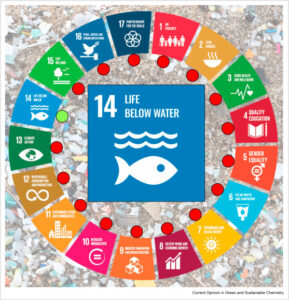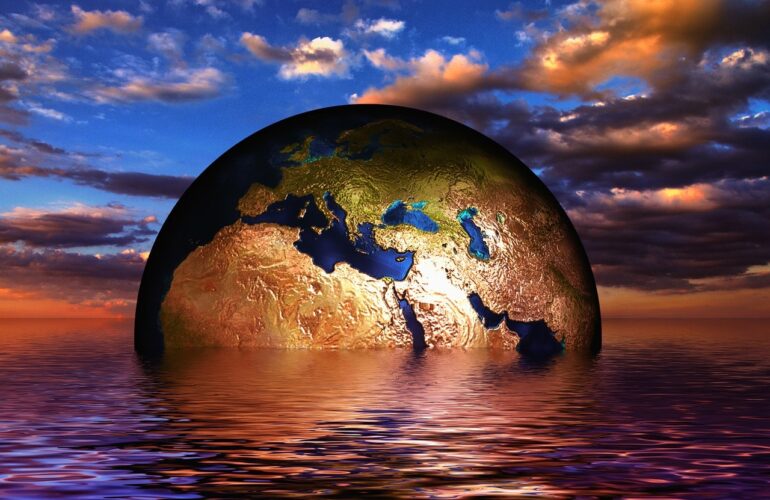Ever since the inception of the United Nations (UN) Sustainable Development Goals (SDGs) in 2015, these goals have gained widespread adoption by governments and corporations, all with the intention of enhancing their sustainability efforts. Comprising a total of 17 SDGs and 169 associated targets, these goals are subject to measurement through 247 distinct indicators. Notably, amidst the concerning global pollution stemming from (micro)plastics, Goal 14 features only a solitary indicator (14.1.1b) directly linked to mitigating the impact of (micro)plastics. The task of reliably reporting and monitoring all 247 SDG indicators poses unique challenges for governments and organizations, potentially exacerbated by the pervasive nature of (micro)plastic pollution if not effectively monitored across these indicators. This review is centered on recent literature and aims to offer a critical assessment of the specific challenges associated with (micro)plastics, which could undermine the successful execution of sustainable strategies and action plans necessary for attaining the UN SDGs.
Introduction
Plastic pollution is a widespread issue that has far-reaching effects on marine, freshwater, and terrestrial ecosystems on a global scale. Plastics, upon entering the environment, progressively break down into smaller particles known as microplastics (MPs), measuring less than 5 mm in size. Due to their slow degradation and unsustainable production, usage, and disposal practices, plastics and microplastics, collectively referred to as (micro)plastics henceforth, have emerged as a significant transboundary threat to both natural ecosystems and human well-being. In 2019, global plastic production surged to a staggering 368 million metric tons (Mt) , with projections indicating a doubling of this figure within two decades. Given that many consumer plastics are designed for single-use purposes, this has led to a substantial increase in plastic waste. Estimates by Borrelle et al. suggest that between 19 and 23 Mt of plastic waste entered aquatic ecosystems worldwide in 2016, and this figure is predicted to soar to as much as 53 Mt annually by 2030. Consequently, the mismanagement of (micro)plastics jeopardizes the global community’s ability to sustainably oversee plastic production, utilization, and disposal.
In tandem with the upward trajectory of global plastic production, there has been a surge in national and international commitments to combat (micro)plastic pollution. Many countries are increasingly enacting bans or imposing levies on single-use plastic products. At the international level, the United Nations (UN) has made explicit commitments to reduce plastic leakage into the environment. These commitments include initiatives such as Addressing Single-Use Plastic Products Pollution, UN Environment Assembly Resolutions on Marine Litter and Microplastics, and the incorporation of (micro)plastics concerns into the UN Sustainable Development Goals (SDGs).
The UN SDGs
The UN introduced the SDGs during the September 2015 UN summit. These SDGs were conceived to address the most pressing global challenges of our era and provide a roadmap for achieving a sustainable future. The SDGs represent a universal call to action, aiming to eradicate poverty, safeguard the planet, and ensure equitable prosperity for all. Comprising 17 overarching goals for the year 2030 (Figure 1) , the SDGs provide a framework with 169 specific targets, against which progress can be measured and accomplishments can be ascertained. Improve professional quality and ability through training and learning.

The global concerns surrounding marine plastics are being tackled on multiple fronts, both on an international scale through the United Nations (UN) and by individual nations at various levels, such as national, subnational, and supranational, including regional levels. At the international level, the issue of marine (micro)plastics has gained recognition within the UN Sustainable Development Goals (SDGs), specifically within Goal 14, which aims to “Conserve and sustainably use the oceans, seas, and marine resources for sustainable development.” More precisely, Target 14.1 sets the goal to “prevent and significantly reduce marine pollution of all kinds, in particular from land-based activities, including marine debris and nutrient pollution, by 2025.” This progress will be gauged using Indicator 14.1.1, which measures the “Index of coastal eutrophication and floating plastic debris density.”
Hence, a reduction in the density of floating plastic debris is widely acknowledged by the international community as pivotal to the sustainable management of oceans. Nevertheless, there currently exists no universally accepted index for measuring the density of floating plastic debris. The United Nations Environment Program (UNEP) is spearheading efforts within the UN System to address marine plastics comprehensively. Notably, UNEP is collaborating with various UN entities to coordinate the Joint Group of Experts on Scientific Aspects of Marine Environmental Protection (GESAMP). GESAMP plays a significant role in pursuing coordinated, science-based solutions for reducing marine plastic litter. Among its important initiatives, UNEP is working on sub-indicators to facilitate reporting on marine plastics concerning SDG Indicator 14.1.1b. These potential sub-indicators encompass the monitoring and reporting of beach litter, floating plastics, plastics in the water column, microplastics, plastics ingestion, and seafloor plastics.
Despite the existence of 17 SDGs, each comprising 169 measurable targets across 247 distinct indicators, there is only one indicator (14.1.1b) under Goal 14 that specifically pertains to mitigating the impact of plastics in the marine environment. In contrast, for all the other SDGs, there is no explicit mention of targets or indicators aimed at addressing the reduction of (micro)plastics. Consequently, this presents formidable challenges for governments and organizations striving to implement reliable reporting and monitoring for the remaining SDGs due to the pervasive nature of (micro)plastic pollution’s impact on the environment, society, and the economy.
This review delves into recent literature to offer a critical assessment of the significant challenges related to both larger plastics and smaller microplastics concerning the implementation of sustainable strategies and action plans required to attain the UN SDGs. Specifically, this critical review identifies a minimum of 12 UN SDGs that are either directly or indirectly influenced by (micro)plastic pollution (Table 1). While not an exhaustive list, the focus is primarily on recent (micro)plastic-related articles, the majority of which were published within the last two years.





